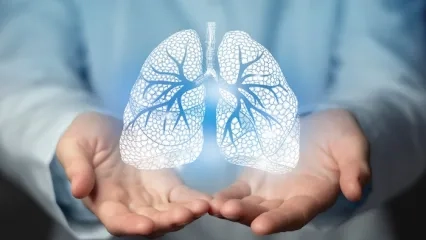Alo Yeditepe
Alo Yeditepe
Lung Cancer Symptoms and Treatment
Lung Cancer is No Longer a 'Male Disease'
Highlighting the increased frequency of lung cancer in women, which was previously known as a "male disease," Seha Akduman pointed out that "In fact, the disease is now more common in men in some regions" and drew attention to the reasons for this...
Lung cancer, resulting from the uncontrolled growth of cells in lung tissue due to damage in DNA, is one of the most common types of cancer worldwide. Mentioning that "the frequency of the disease can vary depending on geographical regions, age, gender, and risk factors," Dr. Seha Akduman, Chest Diseases Specialist at Yeditepe University Hospitals, provided vital information about this insidious disease.
The Most Important Risk Factor in Lung Cancer: Smoking
Lung cancer is primarily associated with certain risk factors, and one of the most crucial risk factors is the use of tobacco and tobacco products. The most significant risk factor is smoking (90% of patients are smokers), followed by passive smoking. Among the known risk factors are genetic factors, radon, arsenic, cadmium, asbestos, mercury, derivatives of petrochemicals, and a history of tuberculosis.
Does Not Show Symptoms in the Early Stages
Lung cancer can be asymptomatic (showing no symptoms) in its early stages, making it challenging to diagnose in an early and more treatable stage. However, as cancer progresses, various symptoms may develop. Specific symptoms can vary depending on the type of lung cancer, the location of the tumor, and the extent of spread. Persistent cough, recurrent pneumonia, bloody sputum, shortness of breath, chest pain, weight loss, changes in nail shape (clubbing), and prolonged hoarseness are among the most significant symptoms of lung cancer.
How Can We Protect Ourselves from Lung Cancer?
Changeable risk factors for lung cancer are factors that individuals can actively change or control through lifestyle changes and behavioral choices. It is important to emphasize that the most significant and preventable risk factor for lung cancer is tobacco use. Quitting smoking is the most effective action you can take to reduce your risk. If you currently smoke, seeking support and resources to quit is strongly recommended. Additionally, minimizing exposure to other changeable risk factors, adopting a healthy lifestyle, following a Mediterranean-style diet, engaging in regular exercise, and not neglecting routine check-ups can contribute to reducing your overall risk of lung cancer and improving your overall health.
Passive Smokers are at Risk of Lung Cancer
Lung cancer is the most common type of cancer worldwide and the leading cause of death in both genders. Approximately 1.8 million new cases of lung cancer are diagnosed globally each year. Lung cancer is responsible for 30% of cancer-related deaths. In individuals who have smoked a pack of cigarettes daily for at least 20 years, one in seven is diagnosed with lung cancer. Smoking is the most significant risk factor in nine out of ten patients. Factors such as the duration and quantity of smoking, the age at which one starts smoking, occupation, and genetic risk factors are crucial. The most common age range for diagnosis is between 50 and 70 years. The daily amount of cigarettes smoked, the number of years of smoking, and the age at which smoking begins are all important factors. Having a family history of lung cancer increases the risk approximately threefold, but smoking increases this risk by 30 times. Groups exposed to cigarette smoke, defined as passive smokers, are also at a significant risk. As these results indicate, the impact of smoking on lung cancer is much greater than that of genetic risk factors.
Lung Cancer Risk Factors
However, other risk factors for lung cancer include exposure to carcinogens such as radon gas, a naturally occurring radioactive gas that can enter homes and buildings from the ground, as well as occupations that increase exposure to carcinogens such as asbestos, arsenic, chromium, and certain industrial chemicals. Long-term exposure to smoke from air pollution or wood stoves can also increase the risk. Individuals who have previously had lung cancer are at a higher risk of developing a second lung cancer. Additionally, the risk is higher in those with a family history of cancer. Certain lung diseases, such as Chronic Obstructive Pulmonary Disease (COPD) and pulmonary fibrosis, can increase the risk of lung cancer.
How Common is Lung Cancer in Women?
While lung cancer was previously more common in men than in women, the incidence of lung cancer in women has been increasing in the past few decades, and in some regions, it has surpassed the incidence in men. Various factors contribute to this change. The increase in the incidence of lung cancer in women is closely linked to changing smoking habits. In the mid-20th century, smoking rates among women increased significantly, contributing to the emergence of lung cancer as a significant health issue for women. Additionally, passive exposure is responsible for 60% of lung cancer cases in women. As women quit smoking or never start, the rates of lung cancer in this group may have stabilized or decreased in recent years.
About
Faculty and Year of Graduation:
Gazi University Faculty of Medicine, 2007
”
See Also
- How to Cleanse Your Lungs?
- Is Breathing Air Dangerous in Fires?
- What is Electronic Cigarette Disease (EVALI)? EVALI Symptoms and Treatment
- What is COPD? Symptoms and Treatment of COPD
- Long Journeys Increase the Risk of Embolism!
- What Asthma and COPD Patients Should Pay Attention to When Using Air Conditioning!
- What is Allergy? What are the Symptoms of Allergy?
- What is Desert Dust? Harms of Desert Dust
- Lung Cancer Screening Age
- What is Good for Cough? How to Cure Cough?
- 10 Ways to Have a Sound Sleep in the Heat
- What Should Asthma Patients Be Cautious About?
- Does Poor Quality Sleep Increase The Risk of Asthma?
- What Causes Insomnia, Diagnosis and Treatment
- 9 Common Misconceptions About COPD
- Causes, Symptoms, and Treatment of Asthma
- Allergy and Asthma During Pregnancy
- It Is Aimed to Eliminate Tuberculosis Worldwide By 2030
- Lung Patients Should Not Stop Their Medications
- 4 Significant Preliminary Symptoms of Lung Cancer
- How Does Acid Rain Affect Human Health?
- The Slowing Traffic in Istanbul Increases the Risk of Cancer!
- The American Cancer Society Has Announced; The Age of Screening For Lung Cancer Has Decreased
- Hidden Lung Cancer Cases Revealed in Tomographs Taken Due to Coronavirus
- Obesity is Both a Cause and Consequence of Sleep Apnea
- Asthma and COPD Attack Season Begins
- Lung Cancer
- Snoring and Its Treatment
- Using Antipyretics Uncontrolled Can Hide Pneumonia Symptoms
Alo Yeditepe




